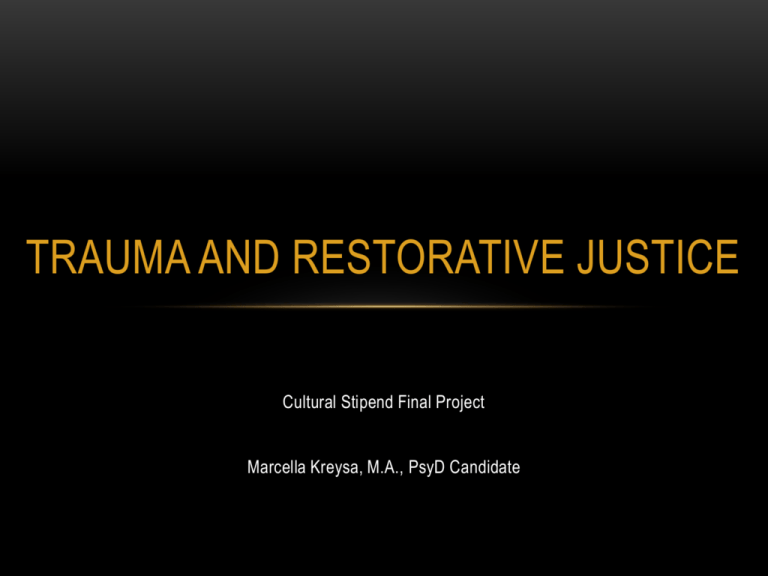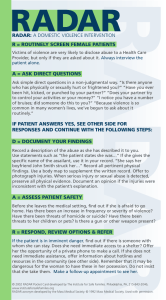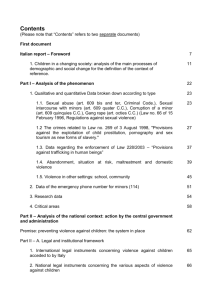
TRAUMA AND RESTORATIVE JUSTICE
Cultural Stipend Final Project
Marcella Kreysa, M.A., PsyD Candidate
THE REALITY OF DOMESTIC VIOLENCE
• Every 60 seconds, 20 people are
victimized by D.V.
• 10 million children witness Domestic
Violence annually
• Children exposed to violence in the
home are 3-4 times more likely to
repeat violence.
• Children living in homes marked by
parental discord, divorce, or domestic
violence, have a higher risk of being
sexually abused
WOMEN AND DOMESTIC VIOLENCE
• 85% of women and 65% of
children seeking shelter, first
reported animal abuse in the
home.
• 1 out of every 3 women have
experienced Domestic Violence
in their lifetime.
• 35 % of women world wide have
experienced either intimate
partner violence and/or sexual
assault.
TEENAGERS AND DOMESTIC VIOLENCE
• Adults currently experiencing Domestic Violence
report their first experience of interpersonal violence
occurred between the ages of 11 and 17.
• 1 in 3 teens is a victim of physical, emotional, or
verbal abuse.
• 1 in 5 girls (11-14 years) have friends experiencing
dating violence
• 2 in 5 girls (11-12 years) report friends who
experience verbal abuse in a relationship
• These girls are more likely to smoke, use drugs,
participate in unhealthy dieting, take part in risky
sexual behavior, and attempt or consider suicide.
NEUROLOGICAL DAMAGE
• Traumatic brain injury (TBI) is an injury to the brain that is
caused by an external physical force on the body that moves
the brain in a specific fashion, as a result causing Diffuse
Axonal Injury.
LONG TERM OUTCOMES OF TBI
• Severe Traumatic Brain Injury
• Significant Problems with;
• Memory Loss
• Change in Mood & Emotions
• Motor issues
• Judgment
• Executive Functions
• Daily Living Activities
• Outcome?
• INSTIITUTIONALIZATION…if you’re “lucky”
TBI CAN INCREASE VICTIMIZATION
•
Persons living with a TBI often have difficulty with anger management, which may prompt
others to use undue physical force or inappropriate medication (Kim 2002).
•
Misperceptions about TBI and its effects may lead to treatment that is demeaning or abusive
(Sequeira and Halsted 2001).
•
TBI outcomes affect others’ perceptions of a person’s ability to honestly and accurately report
an incident of victimization (DOJ 1998).
•
Persons with TBI or other disabilities may experience physical and sexual violence,
emotional abuse, or neglect by a caregiver in return for access to medication, adaptive
equipment, or assistance with activities of daily life (Oktay and Tompkins 2004).
•
A TBI can cause cognitive problems that reduce one’s ability to perceive, remember, or
understand risky situations that could lead to an incident of physical or sexual violence (Kim
2002; Levin 1999).
•
Persons with a TBI may engage in at-risk drinking or drug use that place them in situations or
relationships that lead to episodes of victimization (Kwasnica and Heinemann 1994; Li et al.
2000).
•
• In some persons, a TBI causes uninhibited behaviors that lead to risky sexual engagement,
exposing them to HIV/AIDS or other sexually transmitted diseases (Jaffe et al. 2000; Kramer et
al. 1993).
NEUROBIOLOGY OF TRAUMA
In relationship to trauma severity, victims had:
• A smaller Hippocampus
• A smaller Prefrontal Cortex
• In some cases, smaller medulla
An altered rate of neurodevelopment for
children exposed to developmental trauma
influencing the rate and expression of the
growth and development of the hippocampus,
amygdala,
• Even more disturbing is the recent genome
research that shows an altered gene
expression in victims of trauma …AND
THEIR OFFSPRING.
NEUROBIOLOGY OF VIOLENCE
• Neuropsychological impairments of the executive functions, memory,
attention, intelligence quotient, and empathy have been found in perpetrators
of domestic violence.
• These impairments could be partially explained by alcohol abuse,
dependence, or traumatic brain injuries.
• Functional abnormalities on the prefrontal and occipital cortex, fusiform
gyrus, posterior cingulate gyrus, hippocampus, thalamus and amygdala.
• Perpetrators present with high mental rigidity, as well as low levels of
inhibition, processing speed, verbal and attention skills, and abstract
reasoning. Additionally, perpetrators show working and long play memory
impairments.
SEXUAL ABUSE
• The National Crime Victimization Survey finds that violent crimes against
juveniles are less likely to be known to authorities than are crimes against adults
• 1 in 4 girls and 1 in 6 boys, under 18, are a victim of child sexual abuse
• 3 out of 4 adolescents who have been sexually assaulted were victimized by
someone they knew well
• Over 63% of women who had suffered sexual abuse by a family member also
reported a rape or attempted rape after the age of 14
• Higher rates of re-victimization, which are likely to exacerbate effects of prior
abuse experiences
COMMERCIALLY SEXUALLY EXPLOITED
CHILDREN (CSEC)
• Sex trafficking exploits women, men, and
children across the United States and around
the world
• As many as 1.8 million children are
exploited in prostitution or pornography
worldwide
• Average of entry into commercial sex industry
is 12 years old
• 1 in 3 teens will be recruited by a pimp within
48 hours of running away from home
• At least 100,000 to 300,000 youth are at risk
of becoming CSEC
EFFECTS OF SEXUAL TRAUMA
• Depression
• Low Self-Esteem
• Withdrawal, Feeling of worthlessness
• Suicidal Ideation
• Eating/ Sleep Disturbances
• Distrust
• Regressive Behaviors
• Abnormal/distorted view of sex
• Higher rates of teen pregnancy
• Multiple sex partners with unprotected sex
• Sexually Transmitted Infections
• Substance Abuse
PSYCHOLOGICAL IMPACTS
• Disruption of healthy psychology
development
• Post Traumatic Stress Disorder (PTSD)
• Self-injurious and suicidal behavior
• Dissociative Disorder
• Anxiety
• Paranoia
• Clinical Depression
• Explosive outbursts
• Hyper-sexuality
• Sleep disturbances & nightmares
EMOTIONAL IMPACT OF TRAUMA
• Anger/Rage
• Inability to Self Regulate
• Deep emotional pain and
grieving
• Loss of sexual desire,
feelings, or response
• Feelings of humiliation/shame
• Self-blame/Self-loathing
• Dissociation/Numbing
• Inability to feel joy or
happiness
• Stigma of abuse
PHYSICAL IMPACTS
• Continuous physical abuse in relationships
• Exposure to rape & gang rape
• STDs & STIs
• HIV & AIDS
• Loss of bodily functions
• Pregnancy
• Tattoos/Branding
• Substance abuse/Addiction
• Self-harm behaviors
• Suicide/Death
SOCIAL IMPACTS
• Withdrawal/Isolation from peers
• Obstacles to vocation
• Disconnection from community
• Lack of access to resources
• Separation from mainstream society • Educational deprivation
• Homelessness
• Incarceration/Criminal Record
• Disempowerment
• Lack of life skills
• Distrust
• Difficulty maintaining relationships
• Missed school, disconnection from
school system and support
The Experience
of Trauma
Victim
Perpetrator
BECOMING A PERPETRATOR
• The impact of experiencing violence
• Violence becomes a part of who you are
• Replay modeled behaviors
• Control mastery
• Feel so disempowered that you;
• Fight against others
• Reverse power dynamics
• “Rather hurt, than be hurt”
What Defines a Perpetrator in California?
•
The ‘Dominant Aggressor’ Law: Damage, Escalation, and Intent.
•
Damage: Who has the most visible injuries? (This is a
problem for women with TBI)
•
Escalation: Who elevated the magnitude of the
confrontation?
•
Intent: Who intended to do harm?
WHAT PERPETUATES TRAUMA?
• Racism and oppression
• A system of dominance, power, and privilege based on racial
group designations . . . where members of the dominant
group create or accept their societal privilege by maintaining
structures, ideology, values, and behavior that have the
intent or effect of leaving non-dominant group members
relatively excluded from power, esteem, status, and/or equal
access to societal resources (Harrell, 2000, p. 43)
• Similar to a victim and perpetrator
WHERE DOES TRAUMA AND
VIOLENCE TAKE PLACE?
• Communities of Color
• Low SES neighborhoods
• High unemployment rates
• Low educational
achievement
• Impact of trauma exacerbated
• Lack of resources
THE ROLE OF POWER
• Criminal Justice and other
Institutions
• Similar tenets to racism &
oppression
• Systemic, hierarchy of
power
• Thrives on Dominance
and obedience
DOES THE CRIME FIT THE TIME?
ACLU.org
RESTORATIVE JUSTICE
• Recognition is needed to heal
• Trauma informed
• Gender responsive
• Trauma is COMPLEX
• Case for Race-Based Traumatic Stress
MOVING FORWARD
• Need for:
• Advocacy
• Recognition of systemic role
• Understanding long-lasting
impact of trauma
• Developmental (NMT)
• Empower change










